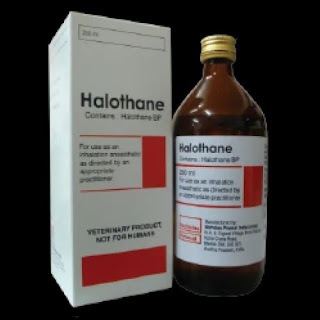Halothane
Halothane, sold under the brand name Fluothane among others, is a general anesthetic. It can be used to start or maintain anaesthesia. One of its benefits is that it does not increase the production of saliva which can be particularly useful in those who are difficult to intubate. It is used by inhalation
Halothane causes a dose-dependent depression of the cardiovascular and respiratory system. Furthermore, halothane, like isoflurane, may inhibit immune function (interferon stimulation of natural killer (NK) cell activity) in mice, and female CBI mice subjected to multiple exposures to halothane anaesthesia before mating may produce increased amounts of specific antibody-secreting B cells accompanied by microscopic fatty changes in the liver. Although halothane does not alter reproductive performance, offspring survival may be lowered.
Halothane has the highest blood/gas partition coefficient of the volatile anaesthetic agents and recovery from halothane anaesthesia is comparatively slow. It is pleasant to breathe. Halothane reduces cardiac output more than any of the other volatile anaesthetics. It sensitises the heart to the arrhythmic effects of catecholamines and hypercapnia; arrhythmias are common, in particular atrioventricular dissociation, nodal rhythm and ventricular extrasystoles. Halothane can trigger malignant hyperthermia in those who are genetically predisposed
Side effects include an irregular heartbeat, decreased effort to breathe (respiratory depression),and liver problems. Like all volatile anaesthetics, it should not be used in people with a history of malignant hyperthermia either in themselves or their family members. It appears to be safe in porphyria.
It is unclear whether use during pregnancy is harmful to the child, and it is not generally recommended for use during a cesarean section. Halothane is a chiral molecule that is used as a racemic mixture.
Halothane, 2-bromo-2-chloro-1,1,1-trifluorethane (1.1.2), is made by the addition of hydrogen fluoride to tricholoroethylene and simultaneous substitution of chlorine atoms in the presence of antimony(III) chloride at 130 °C. The resulting 2-chloro-1,1,1-trifluorethane (1.1.1) undergoes further bromination at 450 °C to form halothane
Medical uses
It is a potent anesthetic with a MAC of 0.74%. Its blood/gas partition coefficient of 2.4 makes it an agent with moderate induction and recovery time. It is not a good analgesic and its muscle relaxation effect is moderate.
Advantages
Halothane is a potent non-flammable inhalational anaesthetic. Induction is smooth and rapid and surgical anaesthesia can be produced in 2-5 minutes. It does not augment salivary or bronchial secretions and coughing is less readily provoked than with ether. The recovery time is rapid and the incidence of postoperative nausea and vomiting is low. It does not react with soda lime and can be used in a closed-circuit system.
Disadvantages
Severe hepatitis, which may be fatal, is a recognized complication of halothane anaesthesia with an incidence of 1:50 000. It is more likely to occur in patients who are repeatedly anaesthetized with halothane within a short period.
Little margin exists between the doses needed to produce respiratory and vasomotor depression. Because of its cardio-depressant effect halothane is usually combined with another inhalational agent, such as nitrous oxide or trichloroethylene, to produce surgical anaesthesia. Muscle relaxants are additionally required to prepare the patient for abdominal surgery. Although it suppresses endogenous sympathetic activity halothane sensitizes the heart to the dysrhythmic effects of catecholamines.
Dosage and administration
Method of administration
Halothane should always be administered using a specially calibrated vaporizer. Vaporizers should be drained at regular intervals and any discoloured halothane discarded. If draw-over machines or inhalers are used, supplementary oxygen or assisted ventilation may be necessary to maintain full oxygenation, even when air is used as the carrier gas. Halothane is not suitable for “open drop” anaesthesia, although a few drops applied to a face mask may smooth the subsequent administration of ether.
Induction
A flow of gas containing at least 30% oxygen should be maintained. Halothane should be introduced gradually and the concentration increased every few breaths until the inspired gases contain 2-3% halothane (for adults) or 1.5-2% (for children).
Maintenance
Concentrations of 0.5-1.5% are usually adequate for adults and children.
Recovery
Recovery time is relatively fast but it varies with the concentrations used and the period of administration. Shivering is common during recovery but it is readily controlled by covering the patient with a warm blanket and, if this is insufficient, by administering chlorpromazine (10 mg i.m.). When it is available, oxygen should be given.
Contraindications
• A history of unexplained jaundice following previous exposure to halothane.
• A family history of malignant hyperthermia.
• Raised cerebrospinal fluid pressure.
Precautions
The patient’s anaesthetic history should be carefully taken to determine previous exposure and previous reactions to halothane. At least 3 months should be allowed to elapse between each re-exposure to halothane. Repeated and frequent administration increases the risk of liver damage.
Premedication with atropine reduces the risk of hypotension and bradycardia. Nevertheless, the pulse and blood pressure must be monitored throughout anaesthesia and the inspired concentration of halothane reduced should hypotension develop. Halothane should be withdrawn if the patient’s condition gives rise to concern.
Use of epinephrine increases the risk of ventricular dysrhythmias. It should be used only by a specialist anaesthetist and if the following precautions are taken:
The total dose should not exceed 20 ml of a 5 micrograms/ml (1:200 000) solution in 10 minutes or 30 ml in 1 hour. Higher concentrations should not be employed.
Ventilation should be adjusted to avoid any risk of hypoxia or hypercapnia.
Use in pregnancy
Halothane should be used during pregnancy only when the need outweighs any possible risk to the fetus. Low concentrations (no more than 0.5%) should be employed in operative delivery to avoid loss of uterine tone and excessive postpartum haemorrhage.
Adverse effects
Cardiac dysrhythmias maybe induced, in particular atrioventricular dissociation, nodal rhythm and ventricular extra-systoles. Hepatic damage occurs in a small proportion of exposed patients. Typically fever develops 2 or 3 days after anaesthesia accompanied by anorexia, nausea and vomiting. In more severe cases this is followed by transient jaundice or, very rarely, fatal hepatic necrosis.
Drug interactions
Halothane potentiates the response to:
- Hypotensive agents, including hexamethonium bromide and trimetaphan camsilate
- non-depolarizing muscle relaxants.
Recovery from anaesthesia may be prolonged when ketamine is used for induction. Concurrent use of suxamethonium may increase the risk of malignant hyperthermia.
Storage
Halothane should be stored in tightly closed amber-glass containers protected from light, below 25°C. Thymol is added as a stabilizing agent to commercially produced supplies at a concentration of 100 micrograms/ml.
Keywords
- Inhalation anesthetic
- General anesthesia
- Side effects of halothane
- Halothane administration
- Halothane dosage
References
- https://www.bjanaesthesia.org.uk/article/S0007-0912(17)37286-0/pdf
- https://www.rxlist.com/fluothane-drug.htm
- https://www.scielo.br/pdf/rba/v61n5/en_v61n5a09.pdf
- https://www.wfsahq.org/components/com_virtual_library/media/a523ce5093daa968de6611b135bd9361-Inhalational-Anaesthetic-Agents—Update-24-2-2008-.pdf
- https://en.wikipedia.org/wiki/Halothane
- https://www.drugbank.ca/drugs/DB01159
- https://pubchem.ncbi.nlm.nih.gov/compound/Halothane
- https://www.sciencedirect.com/topics/neuroscience/halothane

%20(1).jpeg)




0 Comments